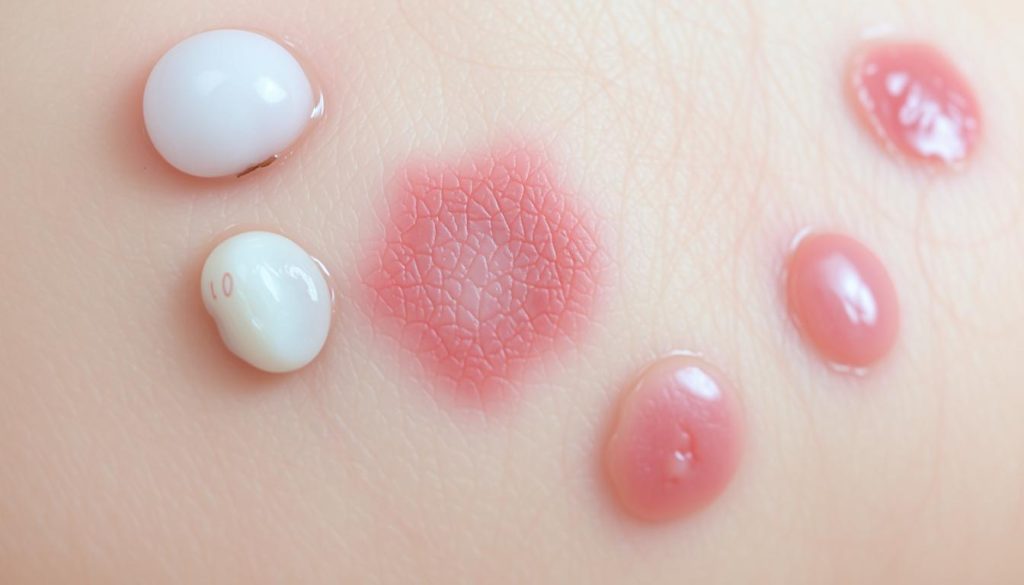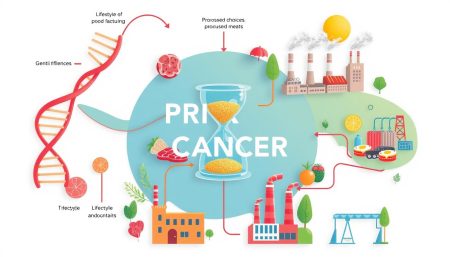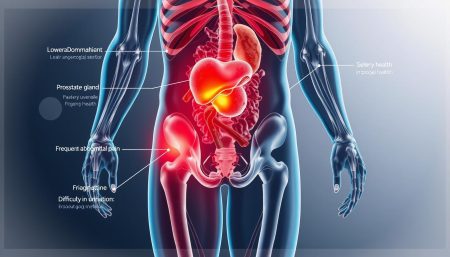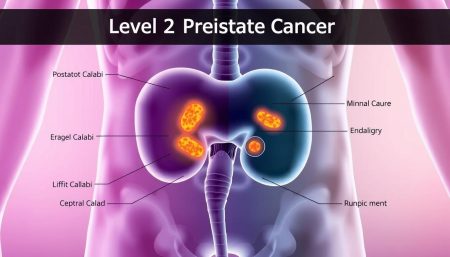Basal cell cancer is the most common skin cancer, affecting millions globally. This guide covers its key aspects, from its traits to risk factors and treatments.
Early detection is key to managing basal cell carcinoma. We’ll explore its symptoms and treatments to help you spot and treat it quickly.
If you’re worried about your skin or want to help someone else, this guide is for you. It offers a detailed look at basal cell cancer, helping you understand it better.
What Is Basal Cell Cancer?
Basal cell cancer is a common skin cancer. It starts in the basal cells, which are at the bottom of the skin’s outer layer. This cancer often shows up on sun-exposed areas like the face and neck.
Definition and Basic Characteristics
Basal cell cancer grows slowly and rarely spreads. It shows up as a skin lesion that won’t heal. This can look like a shiny bump or a dark, scaly patch.
Types of Skin Cancer
There are three main types of skin cancer:
- Basal cell carcinoma
- Squamous cell carcinoma
- Melanoma
Basal cell cancer is the most common but least dangerous. Melanoma is the least common but most serious.
Prevalence and Statistics
In the United States, doctors diagnose over 3.6 million cases of basal cell cancer each year. It’s the most common cancer type. The good news is that it’s highly treatable if caught early.
| Skin Cancer Type | Annual Cases in US | Mortality Rate |
|---|---|---|
| Basal Cell Carcinoma | 3.6 million+ | Less than 0.1% |
| Squamous Cell Carcinoma | 1.8 million+ | Less than 1% |
| Melanoma | 100,000+ | About 20% |
Common Risk Factors for Developing Skin Cancer
Knowing the risk factors for skin cancer helps us prevent it. Sun protection and early detection are key. Let’s look at the main factors that raise the risk of skin cancer, like basal cell carcinoma.
Long-term sun exposure is a big risk. UV rays harm skin cells, which can lead to cancer. People with fair skin are at higher risk because they have less melanin, the natural sun blocker. Those with a family history of skin cancer also face a higher risk, showing the role of genetics.
Other important risk factors include:
- Age: Risk grows with more sun exposure over the years
- Previous skin cancer: Having had skin cancer increases the risk of it coming back
- Immune system suppression: A weakened immune system makes you more susceptible
- Exposure to certain chemicals: Arsenic and radiation can increase skin cancer risk
| Risk Factor | Impact Level | Prevention Strategy |
|---|---|---|
| UV Exposure | High | Daily sunscreen, protective clothing |
| Fair Skin | Medium | Extra sun protection measures |
| Genetic Predisposition | Medium | Regular skin checks, early detection |
| Age | Increasing | Consistent sun protection habits |
By understanding these risk factors, we can improve our sun protection and catch skin cancer early. While some risks are out of our control, we can take many steps to lower our risk of skin cancer.
Understanding the Development of Basal Cell Carcinoma
Basal cell carcinoma is a type of skin cancer. It starts in the basal cells, which are at the bottom of the skin. Let’s look at how it forms and grows.
Cell Formation and Growth
It begins when DNA damage changes the basal cells. These changed cells grow fast, forming a skin lesion. Unlike normal cells, cancer cells keep growing without dying.
Progression Patterns
This carcinoma grows slowly. It rarely spreads to other parts of the body. But, if not treated, it can grow deep into the skin and nearby tissues.
Affected Body Areas
Basal cell carcinoma often appears on sun-exposed areas. Common places include:
- Face, specially nose and eyelids
- Ears
- Neck
- Scalp
- Shoulders
- Back
| Body Area | Percentage of Cases |
|---|---|
| Face | 80% |
| Trunk | 15% |
| Arms and Legs | 5% |
While less common, it can appear anywhere on the body. Regular skin checks help find basal cell carcinoma early. This improves treatment results.
Early Warning Signs and Symptoms
It’s key to spot the early signs of skin cancer for a good treatment. Basal cell carcinoma, a common skin cancer, starts with small changes that are easy to miss. Keeping an eye on your skin and doing self-exams can help find it early.
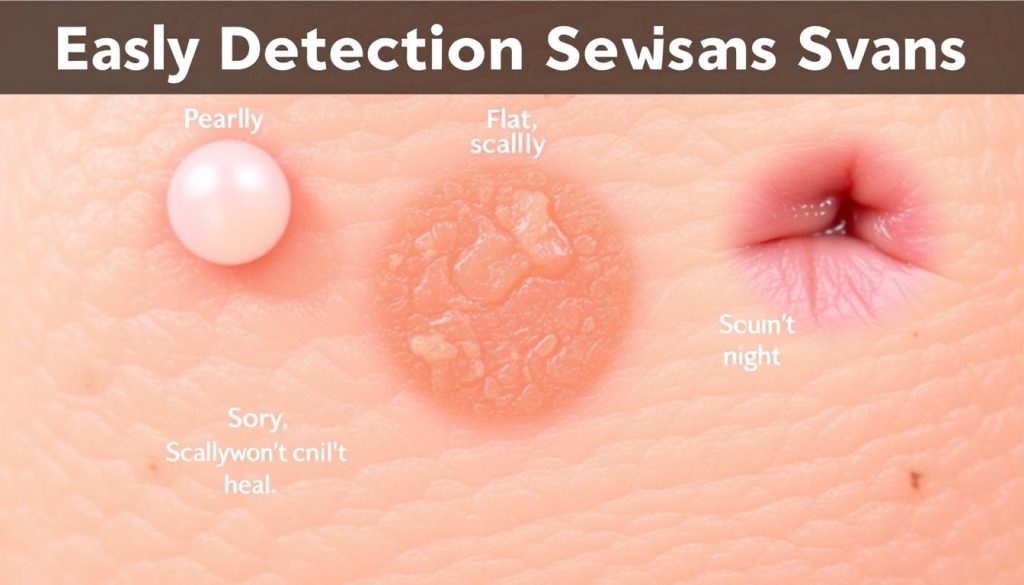
- A pearly or waxy bump on the skin
- A flat, flesh-colored or brown scar-like lesion
- A bleeding or scabbing sore that heals and returns
- A small pink growth with a slightly raised, rolled border
- A reddish patch or irritated area on the face, chest, shoulders, arms, or legs
These signs can grow slowly and look different. Watch for any changes in moles, freckles, or new spots. If you see any of these signs, see a dermatologist right away.
| Warning Sign | Description | Action |
|---|---|---|
| Pearly bump | Smooth, raised lesion with a translucent appearance | Schedule dermatologist appointment |
| Scar-like lesion | Flat, pale or brown area resembling a scar | Document changes and seek medical advice |
| Recurring sore | Wound that bleeds, scabs, heals, then reappears | Immediate dermatological evaluation |
Spotting skin cancer early makes treatment much better. Make checking your skin a regular part of your routine. And don’t wait to see a doctor if you notice anything odd.
Visual Characteristics of Basal Cell Lesions
It’s key to spot basal cell carcinoma early. This common skin lesion has clear signs that differ from harmless growths.
Color Variations
Basal cell lesions look like pearly or waxy bumps. They can be many colors, from flesh-toned to pink, red, or brown. Some may show blood vessels, making them look translucent.
Shape and Border Features
These lesions have irregular edges. They might look like a raised bump or a flat scar. Sometimes, the center is depressed or crusty.
Size and Growth Patterns
Basal cell carcinomas start small, usually under a quarter-inch. They grow slowly, making them easy to miss. As they get bigger, they might bleed or form a central ulcer.
- Initial size: Usually less than 6mm
- Growth rate: Slow but steady
- Bleeding: Common, when irritated
- Ulceration: May form in later stages
Knowing these signs can help you spot suspicious growths. If you see a lesion that looks like this, see a dermatologist. They can check it and might need to biopsy it.
The ABCDE Rule for Skin Cancer Detection
Early detection of skin cancer can save lives. The ABCDE rule helps spot melanomas and other skin cancers. It’s great for finding basal cell carcinoma and other skin changes.
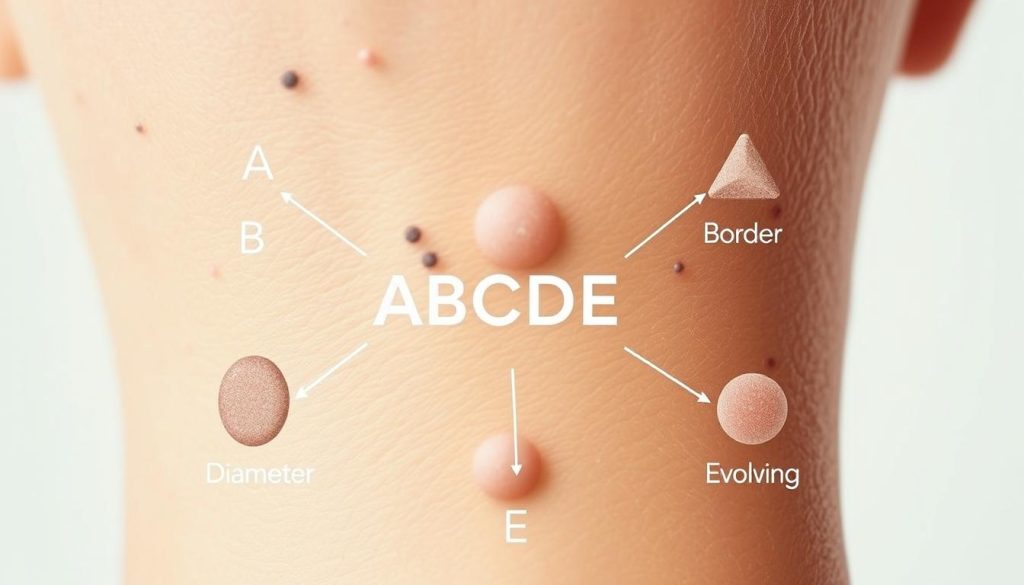
- Asymmetry: One half of the mole doesn’t match the other
- Border: Edges are irregular, ragged, or blurred
- Color: Uneven color or multiple colors within one spot
- Diameter: Larger than 6mm (about the size of a pencil eraser)
- Evolving: Changes in size, shape, or color over time
This rule was made for melanoma but works for basal cell carcinoma too. Basal cell lesions have odd shapes and can change. They look like shiny bumps or flat scars.
Check your skin often with the ABCDE rule. If you see something odd, see a dermatologist fast. Catching skin cancer early makes treatment better.
| ABCDE Feature | Melanoma | Basal Cell Carcinoma |
|---|---|---|
| Asymmetry | Common | Less common |
| Border | Irregular | Often raised or pearly |
| Color | Multiple colors | Usually pink or flesh-colored |
| Diameter | Often >6mm | Can be any size |
| Evolving | Changes rapidly | Slow-growing |
Diagnostic Procedures and Tests
Finding skin cancer early is key to treating it well. Doctors use different ways to spot basal cell carcinoma and other skin cancers. These steps help find odd growths and figure out the best treatment.
Physical Examination Methods
The first step is a detailed skin check. A dermatologist looks closely at the skin for any odd spots or growths. They might use a special tool called a dermatoscope to examine these areas better.
Biopsy Types
If a doctor finds a suspicious spot, they might take a biopsy. There are a few types of biopsies for skin cancer:
- Shave biopsy: A thin layer of skin is removed
- Punch biopsy: A small, round piece of skin is taken
- Excisional biopsy: The whole growth is removed
These tests help doctors know if it’s cancer and what kind. Finding skin cancer early through these methods can lead to better treatment results.
Imaging Studies
Doctors might also use imaging tests to see if cancer has spread. These can include:
- CT scans
- MRI
- PET scans
These tests are not always needed for basal cell carcinoma. But they might be used for more serious cases or other types of skin cancer.
Treatment Options for Basal Cell Cancer
Basal cell cancer needs quick action. Doctors choose treatments based on each patient’s situation. The choice depends on the tumor’s size, location, and stage. Let’s look at the main options.
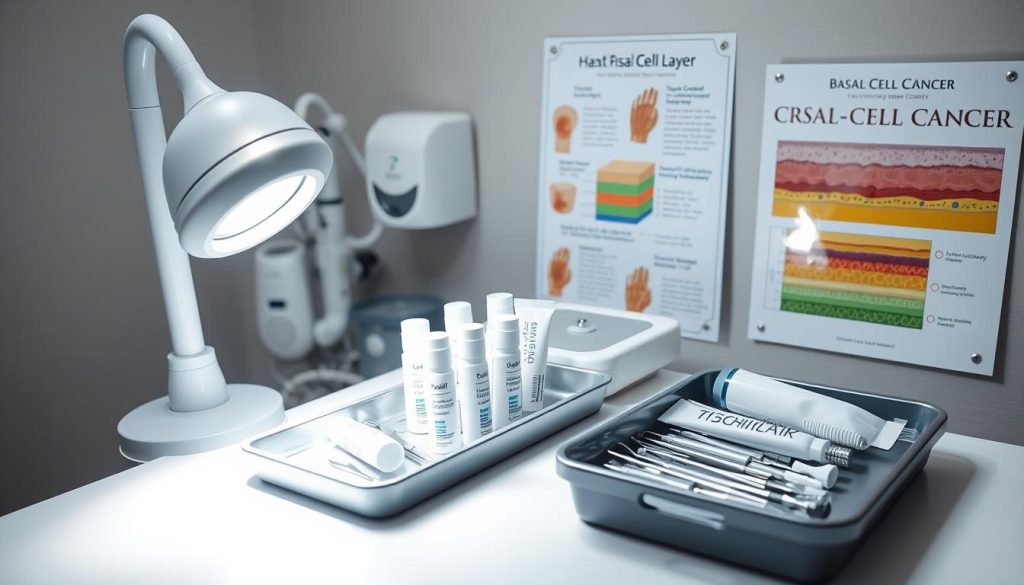
Surgical treatment is often the first choice. It involves removing the cancer and some healthy skin around it. Mohs surgery is a special method that works well. It keeps as much healthy tissue as it can, which is great for areas like the face.
Radiation therapy is another good option. It uses high-energy rays to kill cancer cells. This is useful when surgery isn’t possible. It’s also a good choice for older patients or those with health issues that make surgery risky.
For small tumors, doctors might suggest topical treatments. These medicines are applied directly to the skin to kill cancer cells. They’re often used for low-risk areas or when other treatments aren’t suitable.
- Cryosurgery: Freezing the tumor with liquid nitrogen
- Laser therapy: Using light to destroy cancer cells
- Photodynamic therapy: Combining light-sensitive drugs with special light
Your doctor will talk to you about these options. They’ll consider your health, the cancer’s details, and what you prefer. Remember, catching it early and treating it quickly leads to better results.
Understanding Mohs Surgery
Mohs surgery is a precise way to treat skin cancer. It removes cancerous tissue layer by layer. This ensures all cancer is gone while keeping healthy skin.
Procedure Steps
During Mohs surgery, the doctor takes off a thin layer of skin. Then, they check it under a microscope. This keeps happening until no cancer is found.
Recovery Process
Recovering from Mohs surgery is fast. People can usually go back to normal activities in a few days. The wound might take weeks to fully heal, depending on its size and where it is.
Success Rates
Mohs surgery has high success rates for skin cancer. It works best for basal cell carcinomas, with cure rates up to 99% for first-time cases.
| Type of Skin Cancer | Mohs Surgery Success Rate |
|---|---|
| Primary Basal Cell Carcinoma | 97-99% |
| Recurrent Basal Cell Carcinoma | 94% |
| Primary Squamous Cell Carcinoma | 94-97% |
| Recurrent Squamous Cell Carcinoma | 90% |
This treatment offers high cure rates and less scarring. Its precision is great for visible areas like the face. Here, keeping healthy tissue is key.
Radiation Therapy Approaches
Radiation therapy is key in fighting skin cancer, like basal cell carcinoma. It uses high-energy rays to kill cancer cells. It’s a good option for those who can’t have surgery.
Doctors pick from various radiation types. External beam radiation is common. It sends rays from outside the body to the tumor. Brachytherapy places radioactive material right on the skin.
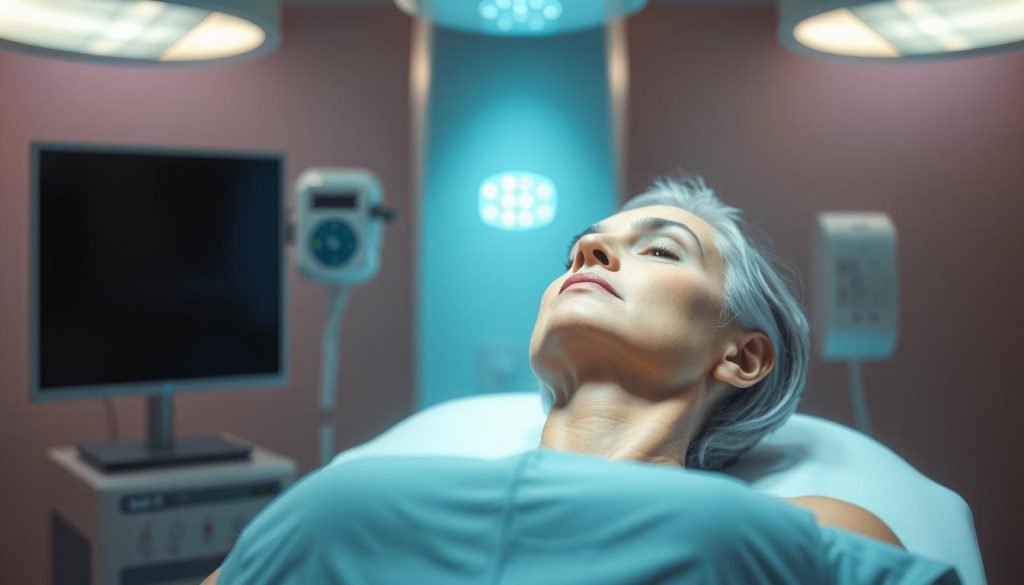
Treatment plans depend on the cancer type and stage. Some get daily treatments for weeks. Others have fewer, stronger sessions. Your doctor will make a plan just for you.
While it works well, radiation therapy can cause side effects. These might include:
- Skin irritation
- Fatigue
- Hair loss in the treated area
- Changes in skin color
Most side effects go away after treatment. Your healthcare team will help with any discomfort.
| Radiation Type | Treatment Duration | Best For |
|---|---|---|
| External Beam | 5-7 weeks | Larger tumors |
| Brachytherapy | 1-2 weeks | Small, surface-level cancers |
| Electron Beam | 3-6 weeks | Shallow skin cancers |
Radiation therapy is great for treating skin cancer in tricky spots like eyelids or nose. It’s also good for older patients who might find surgery hard. Your oncologist will decide if radiation therapy is best for your skin cancer treatment.
Topical Medications and Chemotherapy
Treating basal cell cancer often involves topical medications and chemotherapy. These methods are less invasive. They are good for early stages or for patients who can’t have surgery.
Common Medications
Doctors often use topical treatments for basal cell carcinoma. These include:
- 5-Fluorouracil (5-FU): Cream that stops cancer cell growth
- Imiquimod: Boosts immune response against cancer cells
- Vismodegib: Targets specific genetic mutations in basal cell cancer
Application Methods
Most topical medications are applied directly to the skin. For 5-FU, a thin layer is spread over the affected area. Imiquimod is a cream, applied as your doctor directs. Vismodegib is taken orally in pill form.
Treatment Duration
The treatment length varies based on the medication and cancer severity:
- 5-FU: Usually applied twice daily for 3-6 weeks
- Imiquimod: Often used 5 times per week for 6-16 weeks
- Vismodegib: Taken daily for several months or until the cancer responds
Your doctor will check your progress and adjust the treatment plan as needed. Early detection and treatment of basal cell carcinoma greatly improve outcomes.
Prevention Strategies and Sun Protection
Keeping your skin safe from harmful sun rays is vital to avoid basal cell cancer. Start by making smart choices about when and how you go outside. Stay indoors during peak sun hours, from 10 am to 4 pm, when UV rays are at their strongest.

When you do go out, wear long sleeves, pants, and wide-brimmed hats. Also, use sunglasses with UV protection to protect your eyes and the skin around them. Always apply a broad-spectrum sunscreen with at least SPF 30 to all exposed skin. Reapply every two hours or after swimming or sweating.
Early detection is key to treating basal cell cancer successfully. Regularly check your skin for new or changing moles, growths, or sores. Pay extra attention to sun-exposed areas like your face, ears, neck, and arms. If you spot anything unusual, see a dermatologist right away.
- Seek shade during midday hours
- Wear protective clothing
- Use sunscreen daily
- Check your skin monthly
- Visit a dermatologist yearly for professional skin exams
By combining careful sun protection with regular skin checks, you can greatly lower your risk of basal cell cancer. Remember, prevention is always better than cure when it comes to skin health.
Post-Treatment Care and Recovery
After skin cancer surgery, it’s important to take good care of yourself. This guide will help you heal well and stay healthy in the long run.
Wound Care
Keeping the wound clean and dry is key. Your doctor will tell you when to change the dressing. Look out for signs of infection like redness or swelling.
Wash the wound with mild soap and water every day. This helps it heal faster.
Follow-up Schedule
Going to your doctor’s appointments is important. They will check on your healing and look at your skin. Make sure to keep these appointments.
Monitoring for Recurrence
Keep an eye out for any changes in your skin. Do monthly self-exams to check for new spots. If you notice anything different, tell your doctor right away.
Regular skin checks by a doctor are also important. They help find any problems early.
By taking care of yourself after treatment, you’re helping your health. Following these steps is a big step towards protecting your skin and staying healthy.
Long-term Prognosis and Survival Rates
Basal cell cancer is the most common skin cancer and has a good long-term outlook. Most people can expect to live a long life if caught early. The 5-year survival rate for basal cell carcinoma is nearly 100%, making it one of the most treatable cancers.
Several factors affect the prognosis of basal cell cancer. These include the tumor’s size and location, the type of basal cell carcinoma, and how early it’s detected. Tumors on the face or neck may have a slightly higher risk of recurrence. Research shows that people with a history of skin cancer are at higher risk for new skin cancers.
While the outlook is generally good, staying vigilant is important. Regular skin checks and follow-up appointments help catch new or recurring lesions early. It’s also key to keep up sun-protective habits to lower the risk of more skin cancers.
Some cases of basal cell cancer can be more aggressive or hard to treat. This includes large tumors, those that have spread to nearby tissues, or cancers that have recurred after initial treatment. In these cases, more extensive treatment may be needed, which could affect long-term quality of life.
Early detection is key to maintaining a good prognosis for basal cell cancer. If you notice any unusual changes in your skin, don’t hesitate to seek medical attention. Your dermatologist can give you personalized information about your specific case and long-term outlook.
Impact on Quality of Life
Basal cell carcinoma, a common skin cancer, can really change a person’s life. It can make them feel self-conscious about their body. This is because of the physical changes it causes, like scars or changes in appearance.
These changes are often more noticeable on areas like the face or hands. This can make people worry a lot.
The emotional side of dealing with skin cancer is tough. People might worry about getting cancer again or feel anxious about treatment. They might also be scared of the sun.
Some might even feel sad or pull back from social events. It’s important to find ways to deal with these feelings. Getting support from loved ones and doctors is key.
But, many people with basal cell cancer find ways to keep living well. They might join support groups or learn to manage stress. Taking care of their health and staying positive helps a lot.
With the right care and attitude, most can handle the effects of skin cancer. They can keep living their lives and stay connected with others.
FAQ
Q: What is basal cell cancer?
A: Basal cell cancer is the most common skin cancer. It starts in the basal cells of the skin’s outer layer. It usually appears on sun-exposed areas and rarely spreads.
Q: What are the risk factors for developing basal cell cancer?
A: Risk factors include long sun exposure, fair skin, and genetic predisposition. A history of skin cancer and a weakened immune system also increase risk. Protecting your skin and getting regular checks are key.
Q: What are the early warning signs of basal cell cancer?
A: Look out for a pearly or waxy bump, a flat, flesh-colored or brown scar-like lesion, or a sore that bleeds or scabs. Any skin changes should be checked by a dermatologist.
Q: How is basal cell cancer diagnosed?
A: Diagnosis starts with a physical exam and a biopsy of the suspicious area. Sometimes, imaging studies are used to see how far the cancer has spread.
Q: What treatment options are available for basal cell cancer?
A: Treatments include surgery, radiation, topical medications, and chemotherapy. The choice depends on the tumor’s size, location, and depth.
Q: What is Mohs surgery?
A: Mohs surgery is a method to treat skin cancer. It removes thin layers of skin and checks them until only cancer-free tissue is left. It’s very effective and saves healthy tissue.
Q: How effective is radiation therapy for basal cell cancer?
A: Radiation therapy is very effective for basal cell cancer, often used when surgery isn’t possible. It’s good for tumors in sensitive areas or for older patients who can’t have surgery.
Q: How can I prevent basal cell cancer?
A: Prevent it by protecting your skin from the sun, avoiding tanning beds, and doing regular skin checks. See a dermatologist yearly for professional checks.
Q: What is the long-term outlook for patients with basal cell cancer?
A: The outlook is very good, with a high cure rate if caught early. But, those with basal cell cancer are at higher risk for new cancers, so ongoing monitoring is key.
Q: How does basal cell cancer impact quality of life?
A: It can affect life through physical changes, emotional stress, and the need for ongoing skin checks. But, with the right treatment and support, most patients maintain a good quality of life.












